In recent years, Clear aligners have become a game-changer for teeth straightening. They offer a modern choice instead of traditional metal braces. These clear aligners are custom-made and transparent, making them almost invisible.
They are comfortable and discreet, appealing to both teens and adults. Turkey is now a top spot for affordable, high-quality orthodontic care. More people are choosing clear aligners for their dental needs.
Clear aligners are a modern way to straighten teeth without anyone noticing. They make getting a perfect smile easier and more comfortable. This has changed how we think about dental care.
Clear aligners are custom-made, clear plastic devices that move teeth into place. They work by changing slightly with each new set. People switch them out every one to two weeks to keep moving forward.
These aligners fit tightly over your teeth, moving them gently but effectively. They are almost invisible, thanks to new technology. This makes them more comfortable than traditional braces.
Clear aligners have many benefits over traditional braces. For one, they are much less noticeable. This means you can straighten your teeth without the metal showing.
They are also easy to remove. This makes eating and brushing your teeth simpler. Clear aligners are kinder to your mouth, causing less irritation than braces. They can also work faster, depending on your needs.
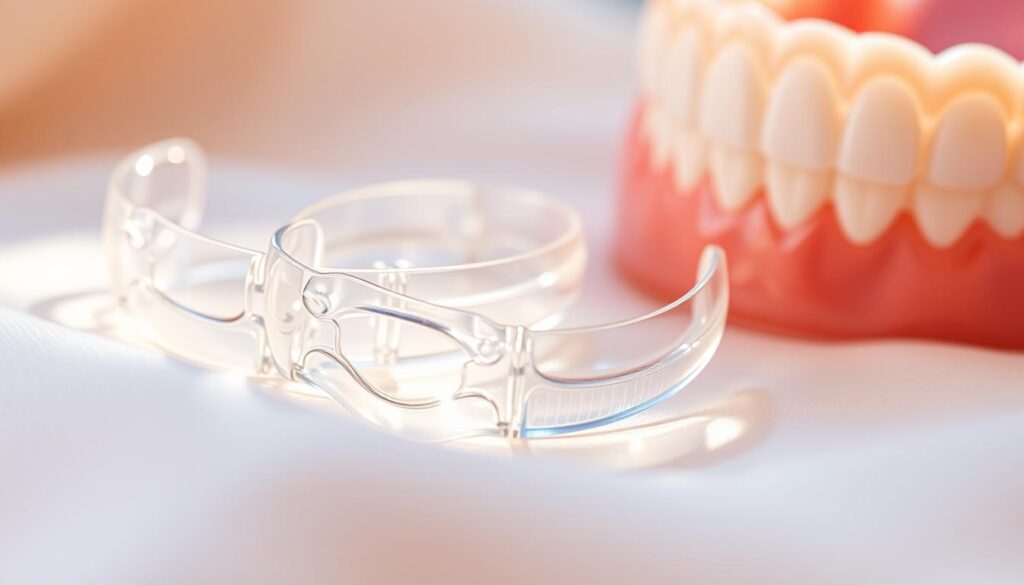
Clear aligners are a new way to get a beautiful smile. It's important to know how they work if you're thinking about them. The whole process, from the first visit to wearing the last aligners, has several key steps.
Clear aligners work by fitting each one to your teeth. Orthodontists use 3D imaging to plan how your teeth will move. You wear each set for about 20-22 hours a day, switching to the next one as your teeth move.
This shows how well the Invisalign system and others work.
Getting clear aligners in Turkey starts with a visit to a dental clinic. First, you need to make an appointment. The orthodontist will check your teeth and take impressions or digital scans.
Then, they will create a treatment plan for you. This plan will tell you what to expect, how long it will take, and how much it will cost. You'll have regular check-ups to get new aligners and make sure you're following the treatment plan.
There are important things to think about when choosing clear aligners. These include:
Talking to an experienced orthodontist can help you choose the right treatment for you.
Turkey is becoming a top choice for orthodontic treatments, especially clear aligners. It offers affordable options, skilled orthodontists, and a discreet treatment. Here are the main reasons why Turkey is a great place for clear aligners.
The cost of clear aligners in Turkey is very appealing. Compared to many Western countries, dental care here is more affordable. Clinics in Turkey offer great prices because of lower costs and better exchange rates.
This allows them to provide quality orthodontic treatment at a lower price. It's a big advantage for those looking for budget-friendly options.
In Turkey, you can find highly trained orthodontists. They have the skills and certifications from top institutions. Many clinics use the latest technology, ensuring they meet international standards.
This means patients get the best care for their needs. It's important for effective treatment and top-notch services.
Clear aligners offer a subtle way to straighten teeth. They are designed to be almost invisible, boosting patient confidence. The aligners are made to fit well, without causing discomfort.
Many patients love the discreet treatment. It fits seamlessly into their daily lives. They can smile freely during the whole process.

Clear aligners are a modern way to straighten teeth. They are discreet and comfortable, making them a top choice for many. This method is perfect for those who want to improve their smile without drawing attention to their teeth.
Clear aligners also make the process easy and convenient. They offer many benefits, like boosting your confidence. This is especially true in Turkey, where dental care is affordable and high-quality.
Skilled orthodontists in Turkey help make the process smooth. This means you can get the smile you want without hassle. Clear aligners are changing how we think about straightening teeth, making it easier and more accessible.
Clear aligners are custom-made, clear orthodontic devices. They help move teeth into proper alignment. You change them every one to two weeks for subtle tooth movement.
Clear aligners are discreet, comfortable, and flexible. They are almost invisible, can be removed for meals and hygiene, and are less irritating to gums than metal braces.
It starts with an orthodontic consultation. A professional checks your dental health and takes digital scans. Then, you get a personalized treatment plan and regular follow-ups for new aligners.
Think about your dental misalignment, treatment time, cost, and aligner brands. It's important to talk to an experienced orthodontist. They can suggest the best aligners for you.
Yes, clear aligners are cheaper in Turkey than in many Western countries. This is due to lower costs and favorable exchange rates. Many clinics also offer payment plans.
You can expect a discreet and comfortable treatment. The aligners fit well and are designed for minimal discomfort. This lets you go about your day without worrying about your teeth.
Treatment time varies by case. It can last from a few months to over a year. This depends on how complex your dental alignment is.
There are many types, like Invisalign and other orthodontic plastic aligners. Each brand has different features and materials for different dental needs.
Orthodontics is a key dental field that deals with crooked teeth. It makes sure your teeth are aligned right. This not only makes your smile look better but also helps your teeth work better.
A straighter smile can really boost your confidence and health. There are many ways to fix crooked teeth, and knowing your options is important. The American Association of Orthodontists says fixing teeth alignment is very important.
In Turkey, many dental clinics offer special services to help people get the smile they want.
Crooked teeth are a common dental problem. They can come from many sources. Knowing these sources helps in preventing and treating them. This part talks about why teeth get crooked and how it affects our health and mind.
The causes of crooked teeth include several factors:
Crooked teeth affect more than just looks. They can harm our oral health in big ways. Problems include:
Teeth that are not straight can really affect our mind. People with crooked teeth often feel:
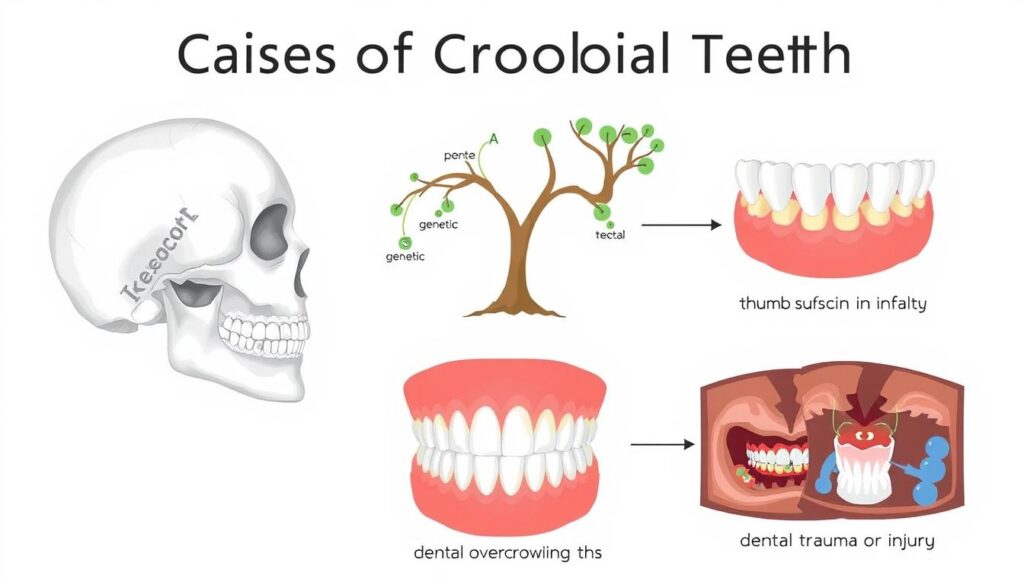
Fixing crooked teeth with orthodontics offers many options. Each one is tailored to fit the patient's needs. Knowing about these treatments helps patients choose the best for their smile.
There are many ways to straighten teeth. Here are some common ones:
| Orthodontic Treatment | Pros | Cons |
|---|---|---|
| Braces | Good for serious problems; flexible | Can be seen; needs regular check-ups |
| Ceramic Braces | Hard to notice; works well | Costs more; might stain |
| Clear Aligners | Hard to see; can be taken out; comfy | Not for all cases; needs discipline |
Finding the right orthodontist is key for good results. Consider these points:
Turkey has many top orthodontic clinics. They have skilled doctors for quality care.
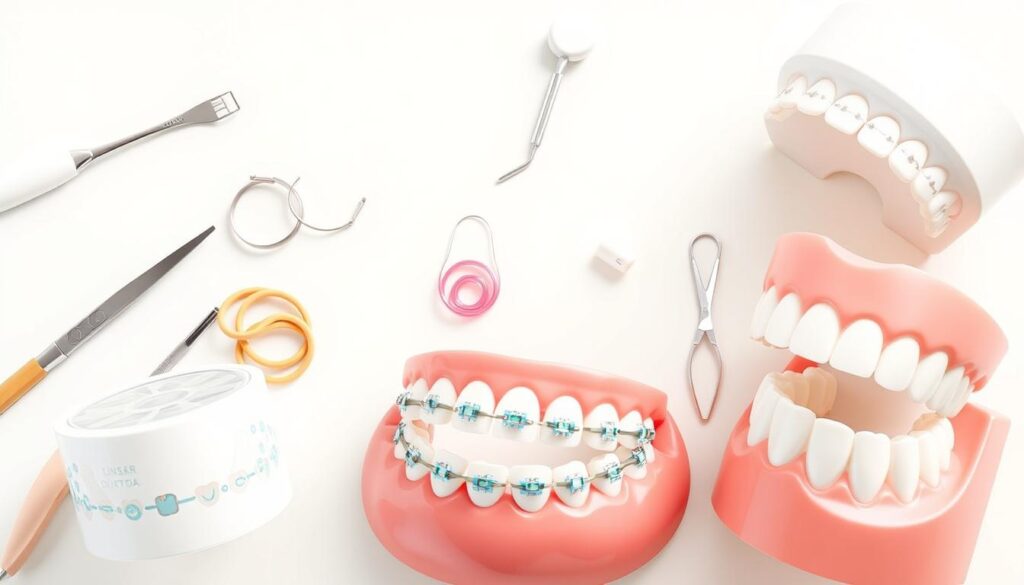
Fixing crooked teeth is not just about looks; it's crucial for health and self-esteem. Orthodontics offers many benefits, like better oral health and less chance of dental problems. It also boosts your mood and self-confidence.
Getting help from a skilled orthodontist might seem scary, but it's worth it. It makes your smile more attractive and boosts your confidence. In Turkey, many experts in orthodontics are ready to help you.
In short, choosing orthodontic care is a smart move for your future. It's about valuing your health and confidence. Start your journey to a straighter smile by talking to an expert today.
Genetics, dental crowding, thumb sucking, and jaw issues are common causes. Prolonged pacifier use in childhood also plays a role.
Crooked teeth make it hard to keep teeth clean. This raises the risk of gum disease and tooth decay. They can also cause jaw pain and discomfort.
Misaligned teeth can lower self-esteem and cause social anxiety. People with crooked teeth may feel shy about their smiles. This can affect their social life and mental health.
You can choose from traditional braces, ceramic braces, or clear aligners like Invisalign. Each has its own benefits and drawbacks, like treatment time and cost.
Look at the orthodontist's qualifications and experience. Check patient reviews and schedule a consultation. This will help you understand their approach and costs.
Yes, orthodontic treatment improves oral health and boosts self-esteem. It can also make you feel more confident and happy with your smile.
Tooth extraction is a common dental procedure. It involves removing a tooth from its socket in the bone. Knowing about the tooth extraction procedure can make patients feel more at ease.
It's important to understand why a tooth might need to be extracted. This could be due to decay, crowding, or other dental issues. Learning about the dental extraction steps can help reduce anxiety and make the experience smoother.
In this guide, we will delve into the details of tooth extractions. We will discuss the reasons behind them and why it's crucial to be well-informed before your appointment.
Tooth extraction is a common dental procedure. It involves removing a tooth from its socket in the bone. This dental procedure explanation helps understand why and when it's done.
The definition of tooth extraction means removing a tooth from its place in the jawbone. It's done to fix serious dental problems like tooth decay or gum disease. Dentists or oral surgeons do this procedure with care, making sure patients know what to expect.
There are two main types of tooth extractions:
Many dental problems can lead to tooth extraction. Some common tooth extraction reasons include:
Dealing with these problems early is key to good oral health. Knowing about tooth extraction is important for dental care.
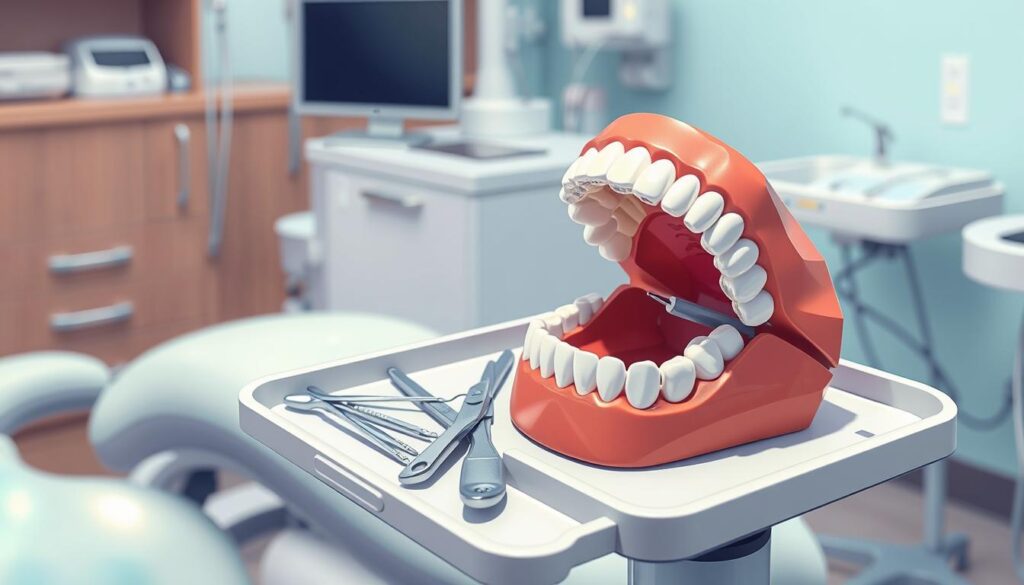
Getting ready for a tooth extraction involves a lot of planning. A detailed dental check-up is key to making sure both the dentist and patient are ready. This part will cover how to prepare, the extraction steps, and the options for pain relief.
The journey starts with a thorough dental check-up, which might include X-rays. Dentists look at your medical history, current meds, and allergies. Talking about pain relief and aftercare is crucial for a smooth experience.
The extraction process usually takes 20 to 40 minutes. First, the dentist uses anesthesia to numb the area. Then, they gently rock the tooth back and forth to loosen it. For surgical extractions, a small cut in the gum might be needed.
After removing the tooth, the dentist cleans the area. They might also stitch it to help it heal properly.
There are different types of anesthesia for tooth extractions. Local anesthesia numbs just the tooth area. Sedation relaxes you during the whole procedure. General anesthesia is for more complex cases, making you sleep through it.
The dentist chooses the best anesthesia based on your comfort, the complexity of the extraction, and their advice.
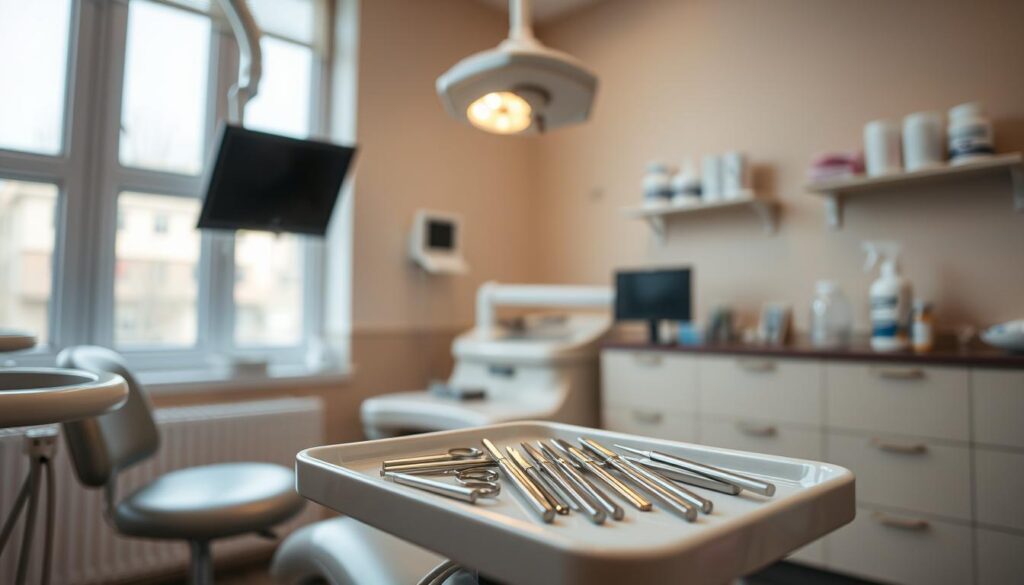
| Anesthesia Type | Description | Ideal Use |
|---|---|---|
| Local Anesthesia | Numbs the specific area around the tooth | Simple extractions or those requiring minimal discomfort |
| Sedation | Relaxes the patient and reduces anxiety | Patients with dental phobia or anxiety |
| General Anesthesia | Renders the patient unconscious | Complex extractions or multiple teeth extractions |
In this tooth extraction overview, we looked at the key parts of the procedure. We talked about the different types of extractions and why people might need them. This helps people understand their dental health better.
Knowing about the procedure's steps, from start to finish, is important. It shows how crucial it is to see a professional dentist. A skilled dentist makes the process smoother and helps with recovery.
Understanding tooth extractions helps patients make better choices for their teeth. Working with a good dentist is key. This way, people can feel better right away and keep their teeth healthy for a long time.
A tooth extraction is when a dentist or oral surgeon removes a tooth from its socket. This is usually needed because of decay or gum disease.
There are two main types of tooth extractions. Simple extractions are for teeth you can see above the gum line. Surgical extractions are for teeth that are harder to reach, like impacted wisdom teeth.
Common reasons for tooth extraction include severe tooth decay and periodontal disease. Overcrowding and impacted wisdom teeth are also reasons. Knowing these reasons helps keep your teeth healthy.
The preparation process starts with a dental exam and X-rays. Your dentist will check the tooth and the tissue around it. They will also talk about your medical history and anesthesia options. This ensures you're ready for the procedure.
The tooth extraction procedure usually takes 20 to 40 minutes. First, anesthesia is given to numb the area. Then, the dentist loosens the tooth. For surgical extractions, an incision might be made in the gum before the tooth is removed.
Anesthesia options include local anesthesia to numb the area, sedation to relax you, or general anesthesia for complex cases. This makes the procedure painless.
Managing pain after a tooth extraction can be done with over-the-counter medications like ibuprofen or acetaminophen. Your dentist may also prescribe pain relief. Always follow their aftercare instructions for the best recovery.
Recovery time after a tooth extraction varies. It can be a few days to a week, depending on the type of extraction and the case's complexity. Following your dentist's aftercare instructions helps with healing.
Cavities are a common dental problem, making it crucial to treat them quickly. Fillings are a common solution in dentistry to fix teeth damaged by decay. They help keep teeth strong and working right.
Fixing cavities early stops them from getting worse. This avoids the need for more serious treatments. We will explore why acting fast is important and how to prevent cavities.
Cavities, or dental caries, are a big problem for our teeth. They happen when bad bacteria make acids that wear down the enamel. Things like bad diet, not brushing well, and not seeing the dentist often can cause cavities. Knowing about cavities helps us take better care of our teeth.
Cavities come in different types. Pit and fissure cavities form on the chewing surfaces of molars. Smooth surface cavities appear on the sides and front of teeth. Both types are caused by the same things that lead to tooth decay. If left untreated, cavities can get worse and cause more serious problems.
It's important to know the signs of cavities. Look out for:
Spotting these signs early can help you get to the dentist before things get worse.
Finding cavities early is key to keeping your teeth healthy. Regular dental visits help catch cavities before they get bad. Early treatment can stop more damage and avoid big fixes later. It also helps keep your overall health good.
| Symptoms | Description | Significance |
|---|---|---|
| Tooth Sensitivity | Discomfort or pain in response to temperature changes. | Indicates potential enamel erosion, requiring attention. |
| Visible Holes | Physical cavities observable on tooth surfaces. | Sign of advanced decay that necessitates immediate care. |
| Pain When Chewing | Discomfort during biting or chewing actions. | May indicate severe decay, potentially leading to infection. |
Dental fillings are a common and effective way to fix cavities. They help restore tooth function and ease pain. This section covers the different types of fillings, the filling process, and the benefits of dental fillings. It aims to help you make informed choices.
There are several dental filling options to meet different needs and preferences. The main types include:
The filling process involves several steps:
Choosing dental fillings has many advantages:
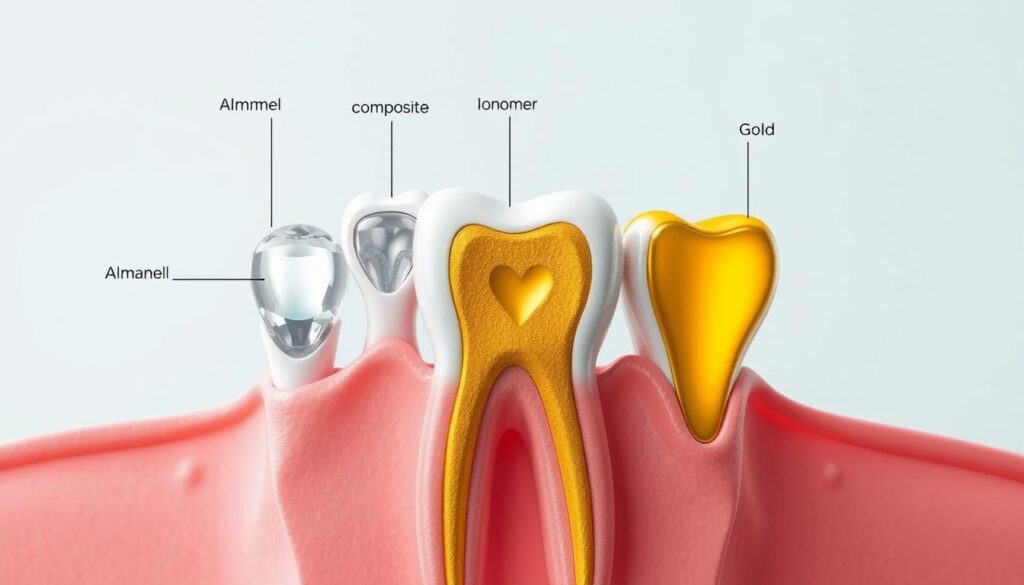
| Type of Filling | Durability | Aesthetic Appeal | Cost |
|---|---|---|---|
| Amalgam | High | Low | Low |
| Composite Resin | Medium | High | Medium |
| Glass Ionomer | Low | Medium | Medium |
| Gold | Very High | Medium | High |
After getting dental fillings, it's key to take good care of them. Knowing how to maintain your fillings and following certain dietary rules can greatly improve your dental health. Here are some tips to help you care for your fillings and spot any signs of trouble.
Good post-treatment care can keep your fillings in top shape. Here are some helpful tips:
Sticking to certain dietary guidelines can also protect your fillings. Try to limit:
Eating fruits, veggies, and foods rich in calcium is good for your teeth and provides important nutrients.
Watch out for signs that your filling might be failing. These could mean you need more dental work. Look out for:
Spotting these signs early can help you get to the dentist quickly. This keeps your dental health a top priority.
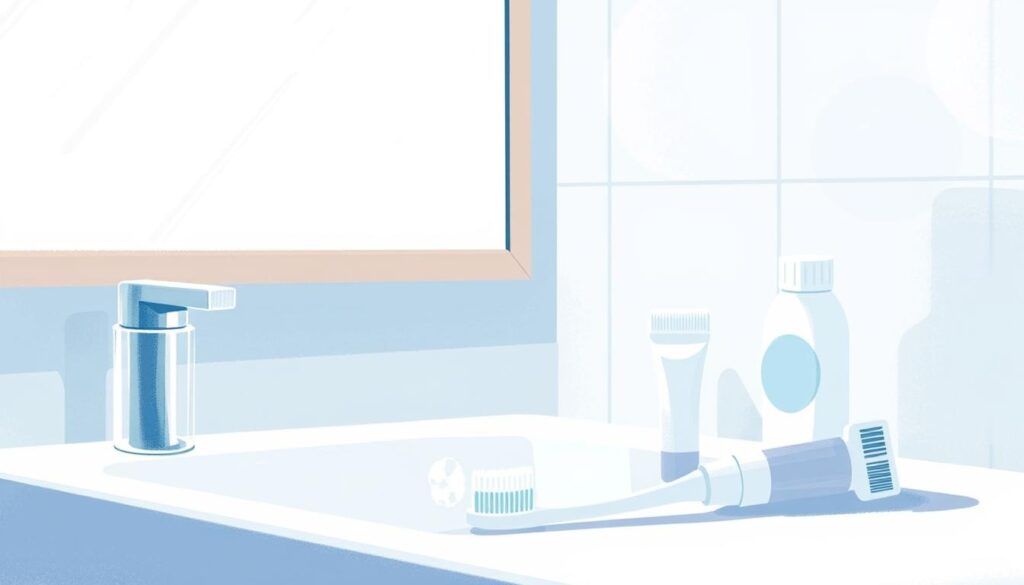
Cavity treatment with fillings is key to keeping your teeth healthy. Knowing what cavities are and how they affect your teeth shows why good oral hygiene is important. Catching signs early helps prevent bigger problems and keeps your teeth strong.
Preventing cavities is also important. Eating right and visiting the dentist regularly can help avoid fillings. Taking care of your teeth keeps them healthy and gives you a beautiful smile.
Don't forget to see your dentist regularly. These visits are crucial for keeping your teeth in top shape. Working with a trusted dentist helps fix problems fast, keeping your smile looking and feeling great.
Cavities, or tooth decay, are small holes in your teeth. They happen when bacteria in your mouth make acids that wear down tooth enamel. This usually happens because of bad dental care and eating too much sugar. You might feel your teeth are sensitive or see damage.
To stop cavities, keep your teeth clean by brushing twice a day and flossing every day. Also, see your dentist often. Eating a balanced diet with less sugar helps a lot.
There are many fillings for cavities, like metal, tooth-colored resin, glass ionomer, and gold. Each has its own good and bad points. Talk to your dentist to find the best one for you.
First, the dentist numbs the tooth area with a local anesthetic. Then, they remove the decayed part. After that, they put in the filling material, shape it, and polish it to make your tooth look and feel normal again.
Fillings help your tooth work and look right again. They stop decay from getting worse and ease pain. They also protect your tooth from more harm.
Take care of your teeth by brushing and flossing well. Avoid hard or sticky foods that could hurt the filling. Go to your dentist for regular check-ups. Try to eat less sugary foods and drinks.
If your filling is failing, you might feel more pain, see it getting darker, or notice cracks. If you see these signs, see your dentist right away for help.
Root canal therapy is a key dental procedure for tooth pain from infection or decay. It removes the infected pulp, cleaning and disinfecting the tooth. This helps relieve pain and protects your dental health.
The American Dental Association says root canal treatments work well, with success rates of 85% to 97%. It's a top choice for those looking to ease tooth pain.
Root canal therapy is a key part of endodontics. It aims to treat tooth infections and keep teeth healthy. Many people worry about this treatment, but knowing the truth can help.
This therapy removes infected pulp from a tooth. It helps stop pain, prevents infection spread, and saves the tooth. A successful treatment lets the tooth work well and keeps your dental health strong.
Many myths surround root canal therapy. One is that it's very painful. But, thanks to new anesthetics, pain is greatly reduced. Another myth is that treated teeth often fail. Studies show that with good care, teeth can stay healthy for a long time.
Lastly, some think losing the pulp means losing tooth function. But, teeth can still work well after treatment.
The root canal procedure has several key steps to treat infected tooth pulp. It aims to ease pain and make the tooth healthy again. Knowing each step can make patients feel more at ease.
The root canal procedure includes a few main steps:
Patients will feel little to no pain thanks to the anesthesia. The whole process usually takes one to two hours. After, some soreness might happen as the anesthesia fades, but this can be managed with pain relievers.
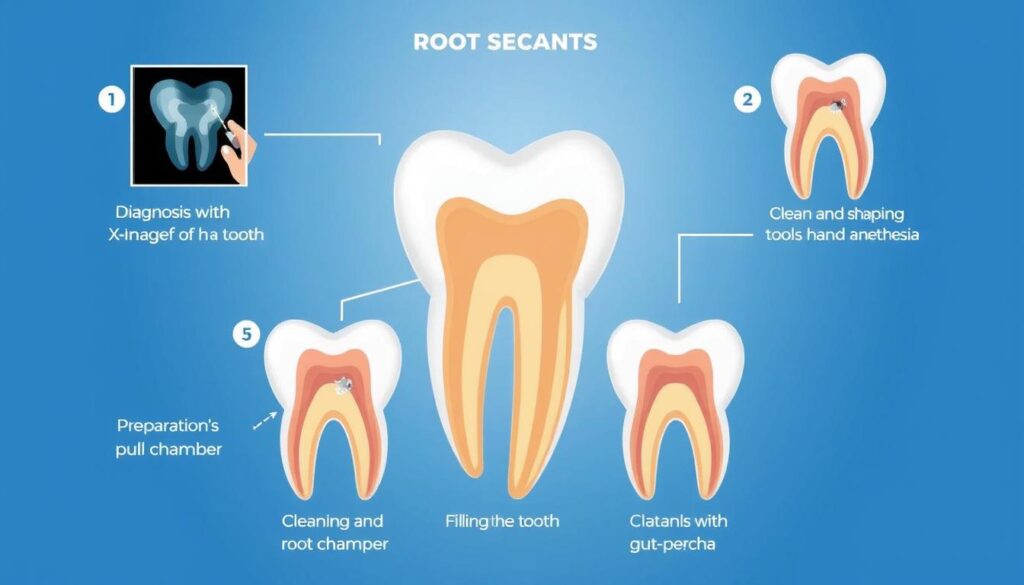
This guide helps patients understand the tooth restoration process. It stresses the need to follow post-procedure instructions for the best recovery.
After a root canal, taking good care of your teeth is key. You need to follow certain steps to heal well and avoid problems.
It's important to listen to your dentist after the treatment. They might tell you to:
These steps help you take care of your teeth after a root canal.
Most people recover well, but watch out for signs of trouble. Look for:
If you notice these signs, tell your dentist right away. Quick action can help your recovery.

Understanding the role of root canal therapy is key for good dental health. It helps keep your natural teeth and avoids more serious treatments. Early treatment is crucial for better results and less pain.
New techniques and technology have made root canals more comfortable. Patients now face less anxiety and enjoy higher success rates. Knowing the benefits of endodontics helps you make better dental choices.
Seeing a dentist early can greatly improve your long-term health. Regular visits and timely treatments like root canals are vital. They not only save your teeth but also boost your overall health. Take care of your teeth today for a healthier future.
A root canal is a treatment to remove infected pulp from a tooth. It helps to stop pain, keep the tooth, and avoid more dental problems.
No, root canals are not painful thanks to modern anesthesia. This makes the procedure comfortable.
A root canal can take from one to two hours. This is the time it takes for the dentist to do the treatment.
After the procedure, you might feel some tenderness. But, following your dentist's aftercare tips will help you recover well.
Signs of complications include more pain, swelling, and sensitivity to hot or cold. If you notice these, call your dentist.
To keep your teeth healthy after a root canal, follow your dentist's advice. Avoid hard foods and brush and floss every day.
Yes, most people need a crown after a root canal. It protects the tooth and helps it function well. Your dentist will tell you if you need one.
Yes, a tooth with a root canal can still get cavities. Regular dental visits and good oral care are key to preventing cavities.
Keeping your teeth clean is key to good dental health. Regular teeth cleaning is important. It removes plaque and tartar, which can cause cavities and gum disease.
In Turkey, eating sugary foods often can harm your teeth. Cleaning your teeth well helps keep your smile bright and your health good. Going to the dentist regularly is also important. It helps find problems early and keeps your smile healthy.
Regular teeth cleaning is key to good oral health. Many people don't see how important it is. A professional dental hygienist uses special tools to remove plaque. This helps prevent cavities and gum disease.
Going for regular dentist cleanings has many benefits. Here are some main advantages:
Finding the right dental cleaning frequency is crucial. Dentists usually suggest cleaning every six months. People with gum disease might need to go more often. Talking to a dentist helps tailor care to your needs.
There are many teeth cleaning misconceptions that can harm dental care:
Knowing the truth about teeth cleaning can clear up these dental myths. It helps foster a better understanding of oral hygiene.
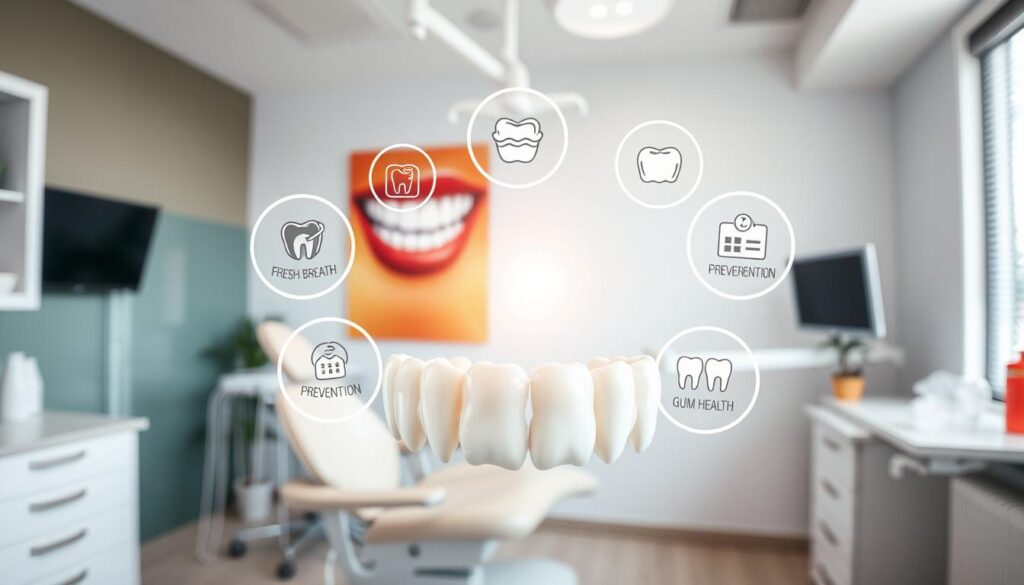
| Frequency of Cleaning | Recommended For | Potential Risks |
|---|---|---|
| Every 6 Months | General population | Higher risk of cavities and gum disease. |
| Every 3-4 Months | Individuals with gum disease | Accumulation of plaque leading to serious issues. |
| Annual | Those with excellent oral hygiene | Potential for unnoticed dental problems. |
To keep your smile healthy, good at-home dental care is key. Following strong oral hygiene tips can greatly improve your dental health. A routine of daily brushing and flossing is crucial to fight plaque and stop cavities.
Using the right techniques makes your dental care more effective. Here are some tips:
Choosing the right dental products is important. Look for:
Reading product reviews and getting recommendations can guide you to the best dental care brands. Being informed about at-home dental care leads to a lifetime of healthy smiles.
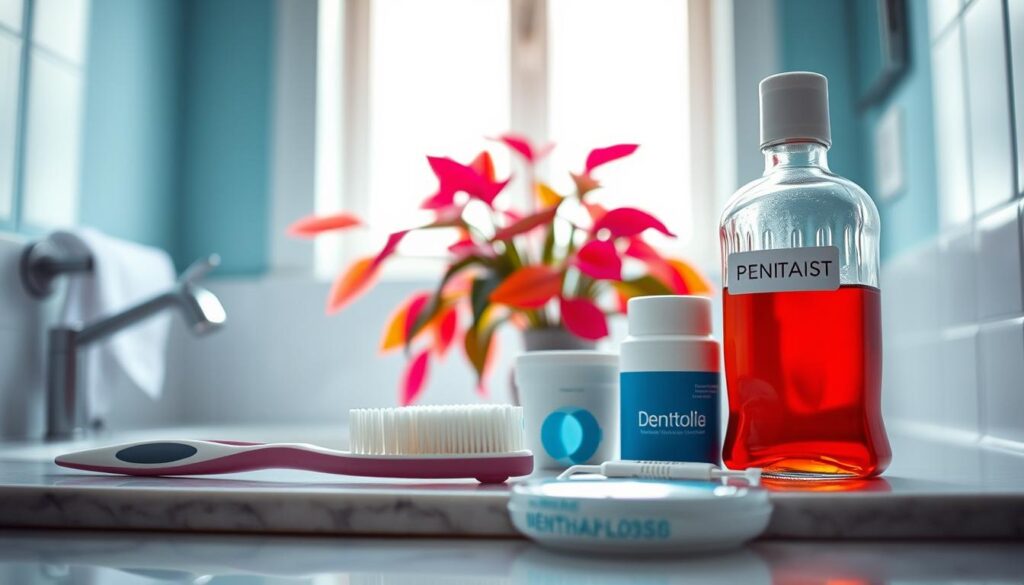
Keeping your teeth clean is key to a healthy smile. The importance of dental health is huge. Regular cleanings and good home care can prevent many dental issues.
In Turkey, going to the dentist often and choosing the right oral care products are important. Learning the truth about dental care helps everyone. It leads to healthier smiles and a more informed community.
By focusing on dental care, you get a brighter smile and a better life. Good dental hygiene brings many benefits. It helps keep your teeth healthy for a long time, improving your overall health.
Professional teeth cleaning keeps your mouth healthy. It stops gum disease and cavities. It also removes plaque and tartar that brushing and flossing can't get.
You should get your teeth cleaned every six months. But, if you have gum disease or other risks, your dentist might say you need more often.
At a teeth cleaning, a hygienist will use special tools to clean your teeth. They'll also check for dental problems and give tips for better oral care.
Brushing and flossing are key for your teeth at home. But, professional cleanings are needed to reach all areas. They remove tartar and prevent problems.
Yes, some think brushing is enough for clean teeth. But, it's not. Professional cleanings remove tartar and prevent problems. Also, modern cleaning is painless.
Brush your teeth twice a day with fluoride toothpaste. Use dental floss or interdental brushes. Mouthwash helps kill bacteria and keeps your mouth clean.
Choose a soft-bristled toothbrush and fluoride toothpaste. Look for brands like Colgate and Sensodyne. An antimicrobial mouthwash also helps keep your teeth healthy.